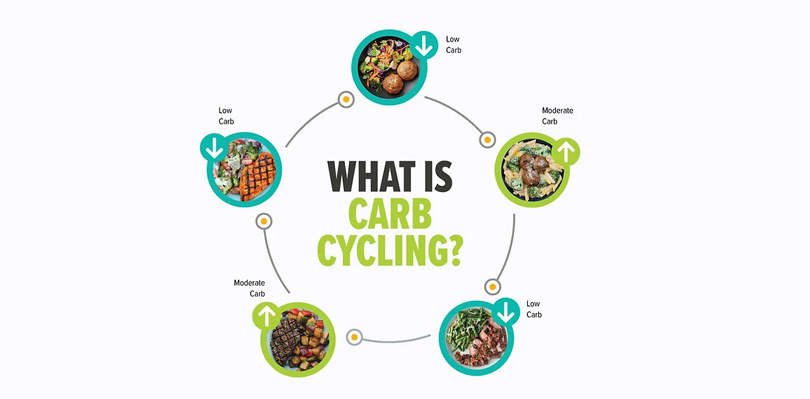The term “carb cycling” is now associated with strategic nutrition and is a cutting-edge dietary practice. In the health and fitness industry, where trends change frequently, carb cycling has proven to be an effective method that has the potential to change how we approach our diets. This approach involves controlling carbohydrate intake and is not just another passing fad. Athletes, bodybuilders, and health enthusiasts worldwide have embraced this well-planned strategy.
What Is Carb Cycling?

Carb cycling is a diet strategy that involves switching between periods of low and high carbohydrate intake. It’s a popular approach among athletes, fitness enthusiasts, and bodybuilders who want to enhance their training performance, build muscles, and manage body fat. The main principle of this practice is to carefully plan and adjust carbohydrate intake in accordance with the body’s energy requirements and physical activity levels.
How Does It Work?
Carb cycling works by controlling carbohydrate consumption in order to control the body’s energy systems, encourage fat loss, and maintain lean muscle mass. This concept is rooted in the body’s reaction to irregular levels of carbohydrates that are the immediate source of energy for most physical functions such as high-intensity workouts.
Here’s how it actually works:
Manipulating Energy Sources
During high-carb days, the body has the opportunity to replenish its glycogen stores in the muscles and liver. Glycogen is the primary energy source for the body during intense physical activities. By incorporating high-carb days into their diet, individuals can ensure that their body has a sufficient supply of glycogen, which enables them to perform well during workouts and other physically demanding tasks.
Encouraging Fat Burning
On low-carb days, when carbohydrate consumption is decreased, the body starts relying on stored fat for energy through a process called lipolysis. This can potentially lead to fat loss because your body burns stored fat for fuel.
Preserving Muscle Mass
During carb cycling, it’s necessary to intake an adequate amount of protein on all days, including low-carb days. This makes sure that your body has enough amino acids to repair and build muscles.
Caloric Cycling
Carb cycling typically involves cycling both carbohydrates and total calorie intake. During high-carb days, it’s usual to take in more calories to support energy expenditure during workouts. Conversely, during low-carb days, calorie intake is reduced to create a calorie deficit that can lead to fat loss over time.
Metabolic Flexibility
Regularly swapping between high and low-carb days can improve the body’s ability to adapt to different energy sources thus improving metabolic flexibility.
Individual Customization
Carb cycling can be tailored according to individual plans and needs. Athletes and fitness enthusiasts can alter the timing and intensity of high and low-carb days based on their workout schedules, recovery needs, and specific performance goals.
Benefits Of Carb Cycling
Carb cycling has earned popularity among individuals searching to improve their athletic performance as well as overall health. Although its efficacy can vary from person to person. Many proponents of this approach report several potential benefits such as:
Improved Fat Loss
By cycling between low-carb days (during which the body uses stored fat for energy) and high-carb days (which support intense workouts) carb cycling can greatly encourage fat loss while maintaining lean muscle mass.
Enhanced Muscle Retention
High-carb days store the energy needed for challenging physical activities. This can help you maintain or build muscle mass, specifically when it is combined with resistance training.
Better Workout Performance
Carbohydrates are the body’s preferred source of energy especially for high-intensity physical activities. High-carb days store enough glycogen needed to improve endurance, strength, and overall workout performance.
Hormonal Balance
Carb cycling may help control hormones such as leptin and ghrelin. These hormones are involved in hunger and satiety. This can help in appetite control, prevent overeating, and contribute to better weight management.
Improved Metabolic Flexibility
Regularly alternating between high and low-carb days can enhance the body’s ability to switch between using carbohydrates and fats for fuel, promoting metabolic flexibility.
Sustainable Approach
For some individuals, it is more tolerable than strict and low-calorie diets. The variety in carbohydrate intake can make the overall dietary plan more enjoyable and easier to stick to in the long run.
Customization
You can customize it according to your needs and goals. Athletes and fitness lovers can adjust their carb intake based on their workout intensity and recovery needs.
Insulin Sensitivity
Some studies suggest that carb cycling may help improve your insulin sensitivity. It is crucial for regulating blood sugar levels. Improved insulin sensitivity can have long-term benefits for overall health and may reduce the risk of type 2 diabetes.
Psychological Benefits
Allowing occasional higher-carb days can provide a mental break from strict dieting, reducing feelings of deprivation and making the overall diet plan more sustainable and enjoyable.
FAQs
Is Carb Cycling Suitable for Everyone?
Carb cycling can be helpful for many people such as athletes, bodybuilders, and fitness enthusiasts. However, it is not a one-size-fits-all approach. Individual responses to it vary based on factors such as metabolism, activity level, and overall health.
Is carb cycling better than no carbs?
Whether carb cycling is better than consuming no carbs depends on individual goals, activity levels, and overall health. Both strategies have their own advantages and limitations, and what works for one person may not be suitable for another.
Why am I gaining weight with carb cycling?
There are several reasons why individuals may gain weight during carb cycling. This includes consuming more calories than needed, overcompensating on high-carb days, temporary water retention due to increased glycogen stores, muscle gain from strength training, hormonal fluctuations, metabolic adaptation, or underlying health conditions.

